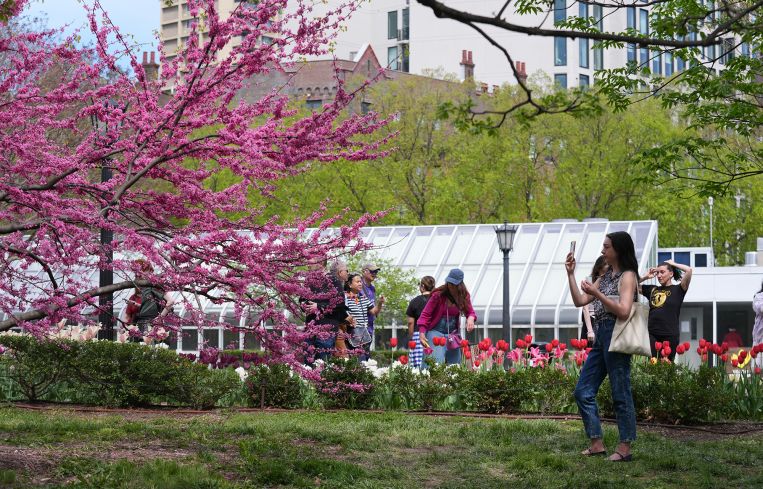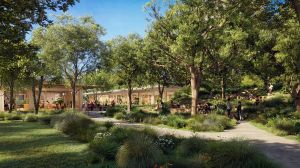Public Park Creation Falling Behind in U.S. Cities as Private Developers Take Over
Firms are behind more than two-thirds of recent parkland, a new report says
By Isabelle Durso October 16, 2025 11:57 am
reprints
Your local park … brought to you by Ye Olde Global Mega Corp.
Private real estate development is driving 67 percent of new park and greenway creation in 10 major U.S. cities, while direct city purchases account for only 5 percent, according to a new report from the nonprofit Trust for Public Land (TPL). That’s a lot of private investment in U.S. parkland, which hasn’t always been the norm.
Historically, when creating a park, a city would set aside land, zone it for a park, and add to it as more land became available. Nowadays, cities aren’t really buying new land for parks or even renovating existing park spaces, largely because pressures to build other types of properties — mainly affordable housing — are piling up.
As a result, cities are leaving park creation more to private developers, who are coming in and building new properties that in the end don’t always include public parks. In other words, the need for parks is getting overlooked.
“This relationship between private development and open space is one that’s sort of perpetual and has really big implications for residents now and for generations to come,” Bianca Clarke, TPL’s initiative lead and associate vice president of its 10-minute walk program, told Commercial Observer.
“Land is a finite resource, and it’s an incredibly important one for our cities and communities, and there are a lot of pressures on how we use that land,” Clarke added. “The problem is, if we use land for uses other than public spaces, it’s really difficult then to create public spaces where we need them.”
And it’s showing up in the numbers. Among the 100 most populous U.S. cities, 64 percent had less park space per resident in 2023 than in 2016, according to TPL’s report. Plus, more than 100 million Americans, including 28 million children, lack access to a high-quality park within a 10-minute walk from their home.
To add on to that, the U.S. is losing an average of 6,000 acres of open space every day, according to data from the U.S. Department of Agriculture.
That strips away vital benefits that parks provide, including protection from flooding and other weather events and places for neighbors to interact and get to know each other. Plus, parks increase property value.
“New York, like a lot of places in the U.S., is experiencing a housing crisis that’s a combination of accessibility and affordability,” Clarke said. “One of the things that we believe is that you need both housing and parks. It’s not an either/or. Green spaces really help protect the longevity of our homes and our housing stock. A strong community needs all of that.”
That’s where city policies come in to protect park land and keep it public. New York was one of the 37 cities that TPL tracked via virtual workshop sessions for its report. The main 10 cities the report analyzed were Aurora, Colo.; Cleveland, Ohio; Columbus, Ohio; Denver, Colo.; Irvine, Calif.; Lewisville, Texas; Lexington, Ky.; Long Beach, Calif.; Portland, Ore.; and Washington, D.C.
New York City’s current laws pertaining to parks are in Title 56 of the Rules of the City of New York and are enforced by Parks Enforcement Patrol officers, rangers and the police. In the city’s roughly 1,700 parks, playgrounds and recreational facilities, current laws include rules prohibiting littering and pollution, the protection of wildlife and natural areas, bans on smoking and fires, and more.
In addition, New York City’s privately owned public spaces (POPS) program — under which most developers operate when they add parkland to a project — requires four critical components to confirm public access. Those are clear design principles, publicly visible signage, the ability to enforce maintenance, and the ability to list the site on a publicly available website.
But it seems like more needs to be done to enforce those rules, as nearly one in five POPS properties does not comply with the city’s program requirements, TPL reported, citing a 2023 New York Times article.
“There’s a combination of privately owned parks, which are places that developers create and then open to the public,” Clarke said. “There’s also places like homeowner associations that are not truly public. They really serve a specific community, and those are more like private parks.”
The privately made parkland can run to the dramatic, too. Cain is including 4.5 acres of public botanical gardens in its One Beverly Hills project in that California city (the multi-billion-dollar project also includes residential towers and a hotel). Other projects are more modest — a patch of grass with benches, a plaza with a fountain and a playground.

“A mix can work, but I don’t think we’ve landed on a perfect formula,” Clarke added. “That’s why we really talk about the policy and the guidance to make sure that these relationships and roles and responsibilities help maintain a green space ecosystem as best it can.”
Besides policy, another part of the puzzle is funding. Parks, which have been “chronically underfunded” for years, need funding for both creation and maintenance so that they’re used for the long term, Clarke said.
But it seems like a lot of that funding is going to housing developments instead, and a lot of the time, those developments can impede on existing parkland or block sunlight from reaching plants.
That was the case at Continuum Company’s failed housing project in Brooklyn’s Crown Heights neighborhood next to the Brooklyn Botanic Garden. Continuum sold the development site at 970 Franklin Avenue in September for $54.3 million after its plans to build a pair of 39-story residential towers with almost 1,600 apartments were shot down over concerns the high-rise towers would cast shadows over the garden and imperil some tropical plants.
That failed deal goes to show that design can be a vital factor when developing near a park.
“There is a lot that we can do with design, and I think there’s a lot of new innovation in construction,” Clarke said. “Both on the building side and also on the park side, materials and design can really help make sure that spaces can exist together.”
In the meantime, city officials and private developers need to work together and prioritize not just new housing, but also new park spaces. “At the end of the day, we need both of these things to exist in our communities,” Clarke said. “Innovations, interesting designs and solutions are out there.”
Isabelle Durso can be reached at idurso@commercialobserver.com.


